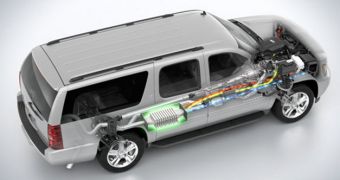Car manufacturers are well aware of the fact that more than 67 percent of the energy that gasoline stores is wasted during the burning cycle as heat. As such, some of them are now turning to testing thermoelectric materials, which hold great promise for making cars more efficient.
This special class contains materials that can absorb heat and produce electricity. Vehicles outfitted with the novel technology will be tested by BMW, Chevrolet and Ford no later than the end of the sumer, Technology Review reports.
What these manufacturers want to do is use thermoelectric semiconductor materials to capture the massive amount of heat current engines produce. The power obtained in this manner will go into fueling an electric engine aboard the vehicles.
This will extend their range considerably, while at the same time making them considerably more fuel efficient. Fuel economy could be improved by at least 5 percent, whereas the fuel needs of such cars or trucks would be diminished substantially as well.
While this technology has been available for years, until now thermoelectric materials have simply been too expensive to be introduced in mass-produced vehicles. But the first affordable prototype thermoelectric generators have just been produced.
Thermoelectric device-maker BSST, of Irwindale, California, and Warren, Michigan-based General Motors Global R&D are the two research groups that independently made advancements in this technology, potentially enabling it to be introduced at a large scale.
These prototypes will be installed in a series of cars. BSST has signed contracts with BMW and Ford, while GM plans to test its technology in Chevrolet SUV. The latter is using thermoelectrics based on a class of chemicals called kutterudites.
These materials are cheaper and more efficient at high temperatures than the bismuth telluride compounds used until now. On the other side of the fence, BSST turned to using blends of hafnium and zirconiu, which the group says increased the efficiency of their generator by 40 percent.
"By a suitable choice of materials, you can affect resistance. The challenge is in arriving at the right formula for materials – both the semiconductor thermoelectric and the contact,” explains Gregory Meisner, a scientist at the GM group.
“Right now, the device is just inserted into the exhaust system. A section of pipe is cut out and the device, which looks like a muffler, is inserted. We need to design something that's more integrated into the vehicle system rather than an add-on device,” he concludes.

 14 DAY TRIAL //
14 DAY TRIAL //